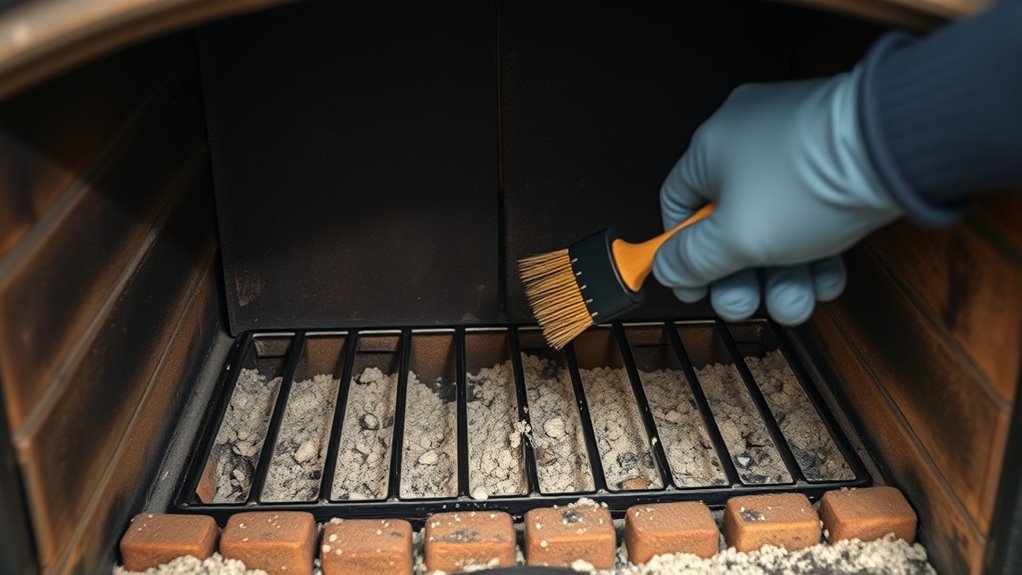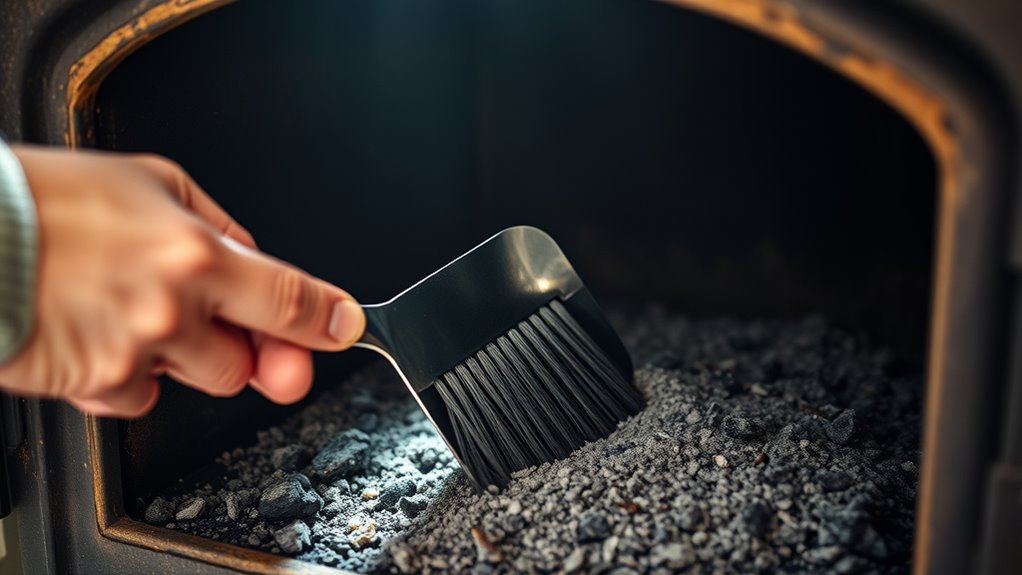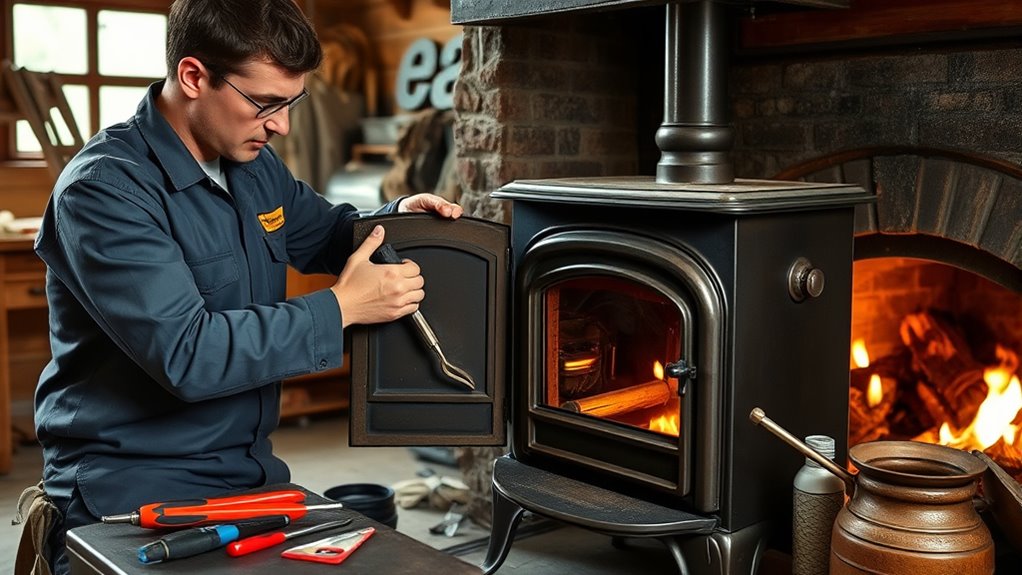To keep your wood stove in top shape, regularly inspect and clean the firebox and burn area, checking for cracks and removing ash safely to improve airflow. Keep the chimney and flue clear of creosote and debris, and replace worn gaskets for a tight seal. Schedule annual professional inspections to catch issues early. Maintaining these key aspects guarantees safe, efficient operation — and there’s more to discover for optimum stove performance.
Key Takeaways
- Regularly inspect and clean the firebox, removing ash and debris to ensure proper airflow and stove efficiency.
- Check and maintain chimney cap and flue liner to prevent blockages, leaks, and chimney fires.
- Remove creosote buildup in the flue with a suitable brush to reduce fire risk.
- Examine and replace gaskets and seals around doors and glass to prevent heat loss.
- Schedule annual professional inspections for comprehensive safety checks and maintenance.
Inspecting and Cleaning the Firebox and Burn Area

Regularly inspecting and cleaning the firebox and burn area is essential to keep your wood stove operating safely and efficiently. Start by checking the firebrick for cracks or damage, as compromised firebricks can reduce heat efficiency and pose safety risks. If you notice any damage, replace them promptly. Clear out ash using proper ash removal techniques—never let ash accumulate too deeply, as it can interfere with airflow and combustion. When removing ash, use a metal scoop and store it in a non-combustible container. Keeping the firebox clean and well-maintained guarantees proper heat circulation and prevents dangerous buildups. Regularly performing these tasks helps your stove operate smoothly, prolongs its lifespan, and keeps your home safe during colder months. Additionally, understanding the importance of chimney and flue system can help you evaluate how well your stove’s visual indicators are functioning, ensuring safe operation and efficiency. Incorporating a regular cleaning schedule can further enhance the stove’s performance and safety. Maintaining proper airflow and combustion efficiency is also crucial for optimal stove performance and safety. Utilizing appropriate ventilation techniques can help improve overall stove operation and safety.
Checking and Maintaining the Chimney and Flue

After cleaning the firebox and removing ash, it’s time to turn your attention to the chimney and flue. Regular inspection guarantees safe, efficient operation. Check the chimney cap for damage or blockages, as it prevents debris and animals from entering. Examine the flue liner for cracks or deterioration, which can cause dangerous smoke leaks. Remove any creosote buildup using a brush designed for your flue size. Ensure the chimney is clear of obstructions that could hinder airflow. Inspect the exterior venting for rust or damage, sealing any gaps. Maintain proper airflow by verifying that the chimney cap is securely in place. Regular checks help prevent chimney fires and improve your stove’s efficiency. Staying proactive with chimney inspection can help identify potential hazards early. Additionally, consulting wood stove maintenance guidelines ensures all components function correctly. Stay vigilant to keep your stove running safely and effectively.
Regularly Removing Ashes and Debris

To keep your wood stove operating efficiently and safely, you need to remove ashes and debris frequently. Regular ash removal prevents buildup that can hinder airflow and reduce heating efficiency. Use a metal ash shovel to carefully scoop out the ashes, making sure they’re completely cooled first. Proper debris clearance also involves removing any loose debris or soot from the firebox and around the grate to promote proper combustion. Keeping the firebox clean ensures better heat transfer and reduces the risk of chimney fires caused by accumulated embers. Always dispose of ashes in a metal container with a lid, away from combustible materials. Routine debris clearance and ash removal are simple but essential steps to maintain your stove’s performance and safety. Additionally, inspecting the shower components periodically can prevent leaks and ensure optimal operation.
Examining and Replacing Gaskets and Seals

Ensuring your wood stove operates efficiently isn’t just about cleaning out ashes; it also involves inspecting the gaskets and seals that keep the firebox airtight. Over time, gaskets can lose their gasket longevity, leading to leaks and reduced heat efficiency. You should regularly check for signs of wear, cracks, or gaps around the door and glass seals. If you notice any issues, it’s time for seal replacement techniques to restore proper sealing. Proper gasket maintenance is essential for maintaining the airtightness of your stove, which directly affects its overall performance and safety. Additionally, understanding the materials used in gaskets can help you select the most durable options for replacement. Knowing the best gasket materials can extend the lifespan of your seals and improve your stove’s efficiency. It’s also helpful to familiarize yourself with gasket replacement tools to make the process smoother. Regularly inspecting and maintaining these components can also prevent heat loss, ensuring your stove performs at optimal levels. – Look for fraying or gaps in the gasket material. – Use a gasket scraper to remove old, damaged material. – Apply high-temperature gasket cement or replace with new gaskets. – Ensure tight, even seating of the new gasket for optimal seal integrity.
Scheduling Professional Inspections and Maintenance

Have you scheduled a professional inspection for your wood stove recently? Regular checkups ensure your stove operates safely and efficiently. During a visit, a technician will inspect the chimney cap to prevent debris and animals from entering, reducing fire risks. They’ll also assess the chimney’s condition, checking for creosote buildup that could cause chimney fires. Don’t forget ash removal techniques—professionals can advise on proper disposal to maintain airflow and stove performance. Scheduling annual inspections helps catch issues early, saving you money and hassle later. Plus, routine maintenance keeps your stove burning cleaner and longer. Making routine maintenance a part of your maintenance routine can help identify potential issues before they become costly problems. Additionally, keeping a maintenance log can help track service dates and any repairs needed. Regular inspections are a key part of preventive care that prolongs the lifespan of your stove and improves safety. Incorporating professional services into your annual upkeep can further enhance the stove’s performance and safety measures. Using AI-powered tools for monitoring your stove’s condition can provide real-time alerts for potential issues, increasing safety and efficiency. Make it a habit to book professional services before the heating season begins, and enjoy a safer, more efficient wood stove all winter.
Frequently Asked Questions
How Often Should I Replace My Wood Stove’s Firebricks?
You might wonder how often to replace your wood stove’s firebricks. Typically, firebrick lifespan varies depending on usage and quality, but most need replacement every 3-5 years. Keep an eye out for cracks, crumbling, or damage, as these signs indicate it’s time for replacement. Regular inspection helps maintain stove efficiency and safety. By monitoring these factors, you ensure your stove stays in top shape and performs at its best.
What Are Signs of a Cracked or Damaged Firebox?
Like a silent alarm, firebox cracks and damage indicators signal trouble. If you notice unusual smoke, odd odors, or reduced heat output, these are signs of a cracked or damaged firebox. Look for visible cracks, warping, or signs of corrosion. These damage indicators can compromise your stove’s safety and efficiency. Addressing these issues early keeps your stove running safely and extends its lifespan, so stay vigilant for these warning signs.
How Can I Improve Stove Efficiency Beyond Cleaning?
To improve your stove’s efficiency beyond just cleaning, consider upgrading insulation around the stove to retain heat better. Installing a catalytic converter can also enhance combustion and reduce fuel consumption. Make sure your door seals tightly to prevent heat loss. These steps help your stove operate more efficiently, saving you money and reducing emissions. Regular maintenance combined with these upgrades guarantees your stove performs at its best for years to come.
Are There Eco-Friendly Options for Stove Maintenance Products?
Imagine a cleaner that’s gentle on your stove and gentle on the planet. You can choose biodegradable cleaners and natural polish options that effectively maintain your stove without harmful chemicals. These eco-friendly options protect your home environment and reduce environmental impact, all while keeping your stove pristine. Switching to these products allows you to care for your stove responsibly, blending sustainability with effective maintenance—because caring for your home shouldn’t cost the earth.
What Safety Precautions Should I Take During Stove Maintenance?
During stove maintenance, prioritize safety by ensuring fire extinguisher readiness nearby. Always wear protective gear like gloves, goggles, and a mask to avoid burns, dust, or fumes. Work in a well-ventilated area and keep flammable materials away. Before starting, double-check that your fire extinguisher is accessible and functioning. Taking these precautions helps prevent accidents and keeps your maintenance routine safe and effective.
Conclusion
Think of your wood stove as a garden that needs constant tending. When you inspect, clean, and maintain regularly, you’re nurturing its health and ensuring it burns bright all season long. Skipping these steps is like neglecting weeds—eventually, they take over. Stay proactive with your stove’s care, and it’ll work smoothly and safely, providing warmth and comfort. Keep up with maintenance, and your stove will be your reliable firekeeper for years to come.











